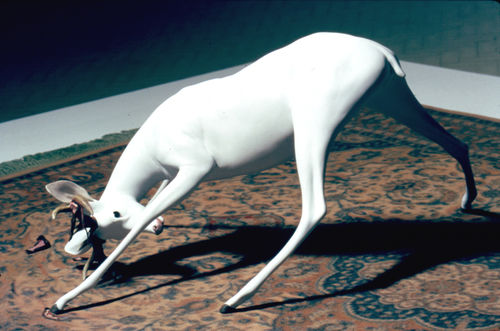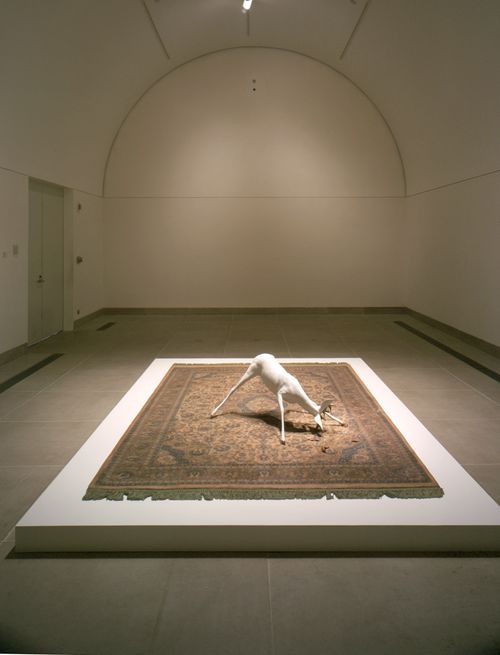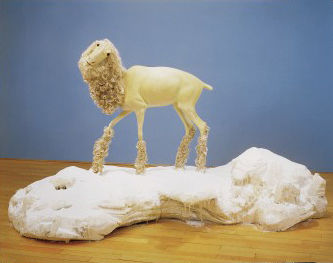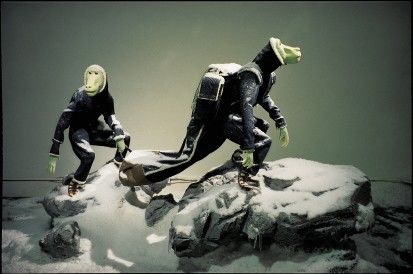
Hammer Projects: Erick Swenson
- – This is a past exhibition
For Texas artist Erick Swenson’s West Coast debut, the Hammer will exhibit an untitled sculpture of a young deer scraping the tender velvet from his antlers onto a resin cast of a large Oriental carpet. Using digital technology to scan the original carpet and an inkjet billboard printer, Swenson has painted the design and color onto the polyurethane resin cast. The room-size installation offers us a haunting juxtaposition of object and creature, both displaced from their original identities and place. Swenson’s Hammer Project exemplifies his sculptures of fantastic creatures caught in surreal situations. These works, startling in their originality and humor, are the result of his lifelong obsession with dioramas, prosthetics, stage sets, and special effects.
Organized by James Elaine, curator of Hammer Projects.

Biography
Erick Swenson was born in 1972 in Phoenixville, Pennsylvania, and currently lives and works in Dallas, Texas. He received his B.F.A. from the University of North Texas, Denton, and has exhibited in Texas and New York, as well as internationally. Recently he has had exhibitions at Angstrom Gallery, Dallas; James Cohan Gallery, New York; Kunstraum München, Munich; and the Museum of Contemporary Art, Sydney, Australia. He was included in the New Orleans Triennial at the New Orleans Museum of Art (2001) and in Out of the Ordinary: New Art from Texas at the Contemporary Arts Museum, Houston (2000). This Hammer Project is Swenson's first exhibition on the West Coast.
Essay
By Charles Dee Mitchell
When I look at notes I've taken on Erick Swenson’s sculptures, I see that I constantly refer to them as something-like. I have notes on creatures that are apelike, sheeplike, and weasel-like. Cast in polyurethane resin and more or less life size, they are sometimes very much like these animals. But the apes wear mountain-climbing gear, the weasel sports a Fair Isle sweater, and there seems to be something off about the sheep’s legs. There is also often a disturbing amount of attention paid to their tiny, very even teeth. If you discount their pristine hairlessness, the young deer Swenson has created over the last two years would possibly pass muster in a natural history diorama, except that in nature fawns don't wear leather chokers around their necks and hind legs. These recent deer, however, are certainly more naturalistic than Edgar (1998). Part horse and part poodle, he was a pitiable and laughable creature who nevertheless, posed atop a snowy crag, maintained a beleaguered dignity. He struck me as Edwin-Landseer’s-Monarch-of-the-Glen-like.
The high level of consciousness and adaptational skills displayed by Swenson’s creations suggests an alternative evolutionary path that has placed them, or perhaps stranded them, in a humanlike position in their world. All we see of EB (2002) is his simian head, which is white and aged, with wrinkles around the eyes and on his cheeks. He is hairless and white, but his red eyes suggest world-weariness rather than albinism. As a sculpture, EB has the sagacious presence of an ancient bust of a Roman senator.
Swenson’s world of hybrids appeared full blown during the summer of 1998 in Obviously a Movie, his first one-person exhibition, produced a year before he would earn his bachelor of fine arts degree from the University of North Texas, Denton. At the Angstrom Gallery in Dallas, Swenson hung perforated PVC pipe across the ceiling, rigged it to revolve, and produced an even fall of shredded plastic snow. It fell on three tableaux featuring some of the creatures already described. Just inside the door, two weasels and a sheep negotiated the leap from a rocky outcropping. Further in, two apes walked across a snowy ridge. The object of their quest seemed to be the magnificent and ridiculous Edgar, who was very much in need of rescue at the far end of the gallery. Obviously a Movie was a theatrical presentation charged with adventure and romance, and the creepy realism of Swenson’s protagonists was integral to the effect. As they acted out their rescue drama, they showed tenderness and concern for one another and for Edgar himself. I feel a little silly saying so, but that is how it worked.
It could be because of the type of narrative I just projected onto what Swenson himself considered three independent sculptures that he immediately began to make changes in his style of presentation. Since 1998 there have been no more groupings of works, only elaborately conceived single images. Two featured a snowy white fawn, in each case snatched up by a flying black opera cape with crimson lining. You can almost hear the defenseless creature bleat. In one work from 2000 Swenson titled the fawn, calling it Muncie, an ambiguous name suited to the genderless nature of its smooth body.
Although it could be that I am once again forcing a narrative onto Swenson’s project, it would appear that in the untitled work now at the Hammer (first exhibited in 2001), Muncie, if it is Muncie, has proved to be male. The central figure here is a young, six-pointed buck, seen with his head down and his rear up, rubbing the velvet off his new growth of antlers. He is not, however, in the forest. He accomplishes his deed in the middle of a seven-by-eleven-foot Persian rug. This rug and its manufacture epitomize the other major change since Swenson’s earliest pieces. In Obviously a Movie, he used taxidermist’s models as a basis for casting his animals and hired costumers to create denim climbing gear and woolen sweaters. Since then he has learned to fully sculpt his own models, and he similarly insists that every element in the piece be a fabrication. So the opera capes that snatch Muncie by the tail are painted castings, not manipulated fabric. For the rug on view here, he made a polyurethane cast of the original, had the rug photographed and scanned, then had the cast inkjet-printed with the original pattern.
Swenson has a keen sense of realism as labor-intensive artifice. He also describes himself as “an advocate of the sad song.” When pressed, his definition of a “sad song” was “those songs that are ridiculously true.” That’s a phrase that neatly captures the experience of his installations. I think of those songs that teeter on the edge of mawkishness but are rescued by superlative technique. Swenson’s always vulnerable creatures may play out their extreme dramas in a realm that draws equally from the Discovery Channel and Cartoon Network, but they embody good stories well told, and I always find myself rooting for them.
A buck sheds his antlers every spring. New ones grow during the three to four summer months. Skin from his head, referred to as velvet, extends to cover and protect the new growth. Tiny capillaries in the velvet provide nourishment for the new bone and make it warm to the touch. By fall the bone has hardened, and the buck rubs off the velvet. He is now ready for practice sparring with other bucks. They are preparing for the rut. That bit of background is perhaps all that needs to be said about Swenson’s untitled work of 2001. Viewers may now project at will onto this image of a young buck spoiling the carpet. I, for one, am on his side. In two separate incarnations, the little fawn Muncie was seized by that sinister opera cape, as if in some Draculean variation on the story of Zeus and Ganymede. Now nature has its revenge on culture, and mating season is just around the corner.
Charles Dee Mitchell, a freelance writer based in Dallas, Texas, is a regular contributor to Art in America and the Dallas Morning News. He has written essays for publications accompanying exhibitions at the Dallas Museum of Art, the Columbus Museum of Art, the Dallas Visual Arts Center, and many other museums and galleries.
Hammer Projects are made possible, in part, with support from the Horace W. Goldsmith Foundation, The Andy Warhol Foundation for the Visual Arts, and the Los Angeles County Arts Commission.
Special thanks to the Cooper Family Foundation for the loan of Untitled, 2001.










